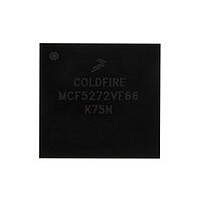MCF5272VF66 Freescale, MCF5272VF66 Datasheet - Page 451

MCF5272VF66
Manufacturer Part Number
MCF5272VF66
Description
Manufacturer
Freescale
Datasheet
1.MCF5272VF66.pdf
(544 pages)
Specifications of MCF5272VF66
Family Name
MCF5xxx
Device Core
ColdFire
Device Core Size
32b
Frequency (max)
66MHz
Instruction Set Architecture
RISC
Supply Voltage 1 (typ)
3.3V
Operating Temp Range
0C to 70C
Operating Temperature Classification
Commercial
Mounting
Surface Mount
Pin Count
196
Package Type
MA-BGA
Lead Free Status / RoHS Status
Not Compliant
Available stocks
Company
Part Number
Manufacturer
Quantity
Price
Company:
Part Number:
MCF5272VF66
Manufacturer:
HYNIX
Quantity:
19
Company:
Part Number:
MCF5272VF66
Manufacturer:
FREESCAL
Quantity:
885
Company:
Part Number:
MCF5272VF66
Manufacturer:
Freescale Semiconductor
Quantity:
10 000
Part Number:
MCF5272VF66
Manufacturer:
FREESCALE
Quantity:
20 000
Company:
Part Number:
MCF5272VF66J
Manufacturer:
Freescale
Quantity:
256
Company:
Part Number:
MCF5272VF66J
Manufacturer:
Freescale Semiconductor
Quantity:
10 000
Company:
Part Number:
MCF5272VF66R2
Manufacturer:
Freescale Semiconductor
Quantity:
10 000
Company:
Part Number:
MCF5272VF66R2J
Manufacturer:
Freescale Semiconductor
Quantity:
10 000
- Current page: 451 of 544
- Download datasheet (7Mb)
TA must always be negated before it can be recognized as asserted again. If held asserted into the following
bus cycle, it has no effect and does not terminate the bus cycle.
TA is not used for termination during SDRAM accesses.
20.2.5
An external slave asserts this active-low input signal to abort a transfer. The assertion of TEA immediately
aborts the bus cycle. The assertion of TEA has precedence over the assertion of TA.
The MCF5272 edge-detects and retimes the TEA input. TEA is an asynchronous input signal.
The TEA signal function is available after reset. If TEA is not used, a pullup resistor or gating logic must
be used to ensure the input is inactive. TEA should be negated on the negating edge of the active chip
select. TEA must always be negated before it can be recognized as asserted again. If held asserted into the
following bus cycle, it has no effect and does not abort the bus cycle.
TEA has no affect during SDRAM accesses.
20.3
When a bus error or an address error occurs during the exception processing sequence for a previous bus
error, a previous address error, or a reset exception, the bus or address error causes a double bus fault. If
the MCF5272 experiences a double bus fault, it enters the halted state. To exit the halt state, reset the
MCF5272.
20.4
The MCF5272 uses the address bus (A[22:0]) to specify the location for a data transfer and the data bus
(D[31:0] or D[31:16]) to transfer the data. Control signals indicate the direction of the transfer. The
selected device or the number of wait states programmed in the chip select base registers (CSBRs), the
chip select option registers (CSORs), the SDRAM configuration and SDRAM timing registers (SDCR,
SDTR) control the length of the cycle.
The MCF5272 clock is distributed internally to provide logic timing. All SRAM and ROM mode bus
signals should be considered as asynchronous with respect to CLKIN. SDCR[INV] allows the SDRAM
control signals to be asserted and negated synchronous with the rising or falling edge of SDCLK. The
SDRAM control signals are BS[3:0], SDBA[1:0], RAS0, CAS0, SDWE, A10_PRECHG, SDCLKE, and
CS7/SDCS.
The asynchronous INT[6:1] signals are internally synchronized to resolve the input to a valid level before
being used.
Freescale Semiconductor
Bus Exception: Double Bus Fault
Bus Characteristics
Transfer Error Acknowledge (TEA)
For the MCF5272 to accept the transfer as successful with a transfer
acknowledge, TEA must be negated throughout the transfer.
MCF5272 ColdFire
®
Integrated Microprocessor User’s Manual, Rev. 3
NOTE
Bus Operation
20-3
Related parts for MCF5272VF66
Image
Part Number
Description
Manufacturer
Datasheet
Request
R
Part Number:
Description:
Mcf5272 Coldfire Integrated Microprocessor User
Manufacturer:
Freescale Semiconductor, Inc
Datasheet:

Part Number:
Description:
MCF5272 Interrupt Service Routine for the Physical Layer Interface Controller
Manufacturer:
Freescale Semiconductor / Motorola
Datasheet:

Part Number:
Description:
TOWER ELEVATOR BOARDS HARDWARE
Manufacturer:
Freescale Semiconductor
Datasheet:

Part Number:
Description:
TOWER SERIAL I/O HARDWARE
Manufacturer:
Freescale Semiconductor
Datasheet:

Part Number:
Description:
LCD MODULE FOR TWR SYSTEM
Manufacturer:
Freescale Semiconductor
Datasheet:

Part Number:
Description:
DAUGHTER LCD WVGA I.MX51
Manufacturer:
Freescale Semiconductor
Datasheet:

Part Number:
Description:
TOWER SYSTEM BOARD MPC5125
Manufacturer:
Freescale Semiconductor
Datasheet:

Part Number:
Description:
KIT EVALUATION I.MX51
Manufacturer:
Freescale Semiconductor
Datasheet:

Part Number:
Description:
KIT DEVELOPMENT WINCE IMX25
Manufacturer:
Freescale Semiconductor
Datasheet:

Part Number:
Description:
TOWER SYSTEM KIT MPC5125
Manufacturer:
Freescale Semiconductor
Datasheet:

Part Number:
Description:
TOWER SYSTEM BOARD K40X256
Manufacturer:
Freescale Semiconductor
Datasheet:

Part Number:
Description:
TOWER SYSTEM KIT K40X256
Manufacturer:
Freescale Semiconductor
Datasheet:

Part Number:
Description:
Microcontrollers (MCU) MX28 PLATFORM DEV KIT
Manufacturer:
Freescale Semiconductor
Datasheet:

Part Number:
Description:
MCU, MPU & DSP Development Tools IAR KickStart Kit for Kinetis K60
Manufacturer:
Freescale Semiconductor
Datasheet:

Part Number:
Description:
24BIT HDMI MX535/08
Manufacturer:
Freescale Semiconductor
Datasheet:











